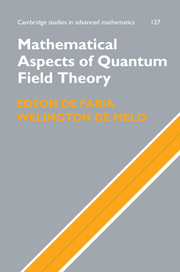Book contents
- Frontmatter
- Contents
- Foreword
- Preface
- 1 Classical mechanics
- 2 Quantum mechanics
- 3 Relativity, the Lorentz group, and Dirac's equation
- 4 Fiber bundles, connections, and representations
- 5 Classical field theory
- 6 Quantization of classical fields
- 7 Perturbative quantum field theory
- 8 Renormalization
- 9 The Standard Model
- Appendix A Hilbert spaces and operators
- Appendix B C* algebras and spectral theory
- Bibliography
- Index
Preface
Published online by Cambridge University Press: 05 March 2013
- Frontmatter
- Contents
- Foreword
- Preface
- 1 Classical mechanics
- 2 Quantum mechanics
- 3 Relativity, the Lorentz group, and Dirac's equation
- 4 Fiber bundles, connections, and representations
- 5 Classical field theory
- 6 Quantization of classical fields
- 7 Perturbative quantum field theory
- 8 Renormalization
- 9 The Standard Model
- Appendix A Hilbert spaces and operators
- Appendix B C* algebras and spectral theory
- Bibliography
- Index
Summary
In this book, we attempt to present some of the main ideas of quantum field theory (QFT) for a mathematical audience. As mathematicians, we feel deeply impressed – and at times quite overwhelmed – by the enormous breadth and scope of this beautiful and most successful of physical theories.
For centuries, mathematics has provided physics with a variety of tools, oftentimes on demand, for the solution of fundamental physical problems. But the past century has witnessed a new trend in the opposite direction: the strong impact of physical ideas not only on the formulation, but on the very solution of mathematical problems. Some of the best-known examples of such impact are (1) the use of renormalization ideas by Feigenbaum, Coullet, and Tresser in the study of universality phenomena in one-dimensional dynamics; (2) the use of classical Yang–Mills theory by Donaldson to devise invariants for fourdimensional manifolds; (3) the use of quantum Yang–Mills by Seiberg and Witten in the construction of new invariants for 4-manifolds; and (4) the use of quantum theory in three dimensions leading to the Jones–Witten and Vassiliev invariants. There are several other examples.
Despite the great importance of these physical ideas, mostly coming from quantum theory, they remain utterly unfamiliar to most mathematicians. This we find quite sad. As mathematicians, while researching for this book, we found it very difficult to absorb physical ideas, not only because of eventual lack of rigor – this is rarely a priority for physicists – but primarily because of the absence of clear definitions and statements of the concepts involved. This book aims at patching some of these gaps of communication.
Information
- Type
- Chapter
- Information
- Mathematical Aspects of Quantum Field Theory , pp. xi - xivPublisher: Cambridge University PressPrint publication year: 2010
